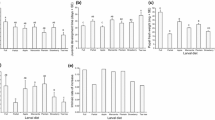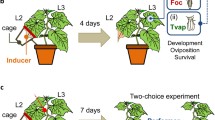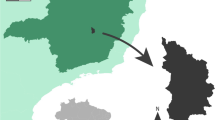Summary
Endophagous folivores, which are concealed inside leaf tissue for much of their life cycle, or which live externally but feed internally, should be more successful on heavily defended plants than ectophagous species. This is because endophages are more facile at feeding selectively and can manipulate tissue development to avoid physical and chemical defenses and to enhance nutrition. As a result, endophage-ectophage ratios should increase on more heavily defended hosts. This pattern will likely be strengthened by negative asymmetrical interactions with ectophages and pathogens, which may displace endophages from lightly defended hosts. The hypothesis predicts that endophages should be particularly abundant in resource-poor habitats which seem to support a preponderance of heavily defended hosts. Although data do not yet exist for a rigorous test, several observed cases where endophage distributions seem biased toward heavily defended hosts are at least consistent with the hypothesis. Plant defense levels may have little influence on the total number of herbivores associated with a host, but I suggest that guild structure can be profoundly altered.
Similar content being viewed by others
References
Root, R. B. (1973) Organization of a plant-arthropod association in simple and diverse habitats: the fauna of collards (Brassica oleracea).Ecol. Monog. 43, 95–124.
Rosenthal, G. A. and Janzen, D. H. (eds) (1979)Herbivores: Their Interaction With Secondary Plant Metabolites, Academic Press, NY, USA.
Saunders, J. A. and Conn, E. E. (1978) Presence of the cyanogenic glycoside dhurrin in isolated vacuoles from sorghum.Pl. Physiol. 61, 154–7.
Schultz, J. C. (1983) Habitat selection and foraging tactics of caterpillars in heterogeneous trees. InVariable Plants and Herbivores in Natural and Managed Systems (eds R. F. Denno and M. S. McClure) Academic Press, NY, USA, pp. 61–90.
Scriber, M. and Slansky, F. Jr (1981) The nutritional ecology of immature insects.Ann. Rev. Ent. 26, 183–211.
Sehgal, V. K. (1971) Biology and host plant relationships of an oligophagous leaf minerPhytomyza matricariae Hendel (Diptera: Agromyzidae).Quaestiones Entomologicae 7, 255–80.
Sharik, T. L. and Barnes, B. V. (1976) Phenology of shoot growth among diverse populations of yellow birch (Betula allegheniensis) and sweet birch (B. lenta).Canad. J. Bot. 54, 2122–9.
Smiley, J. T. (1978) Plant chemistry and the evolution of host specificity: new evidence fromHeliconius andPassiflora.Science 201, 745–7.
Southwood, T. R. E., Moran, C. and Kennedy, C. (1982) The richness, abundance, and biomass of arthropod communities on trees.J. Anim. Ecol. 51, 635–49.
Stipanovic, R. D. (1983) Function and chemistry of plant trichomes and glands in insect resistance. InPlant Resistance to Insects (ed. P. A. Hedin), Amer. Chem. Soc. Symp., Ser. 208.
Strong, D. R., Lawton, J. H. and Southwood, T. R. E. (1984)Insects on Plants: Community Patterns and Mechanisms, Blackwell, Oxford, UK, 313 pp.
Swain, T. (1978) Plant-animal coevolution: a synoptic view of the paleozoic and mesozoic. InBiochemical Aspects of Plant and Animal Coevolution (ed. J. B. Harborne), Academic Press, NY, USA, pp. 1–19.
Swain, T. (1979). Tannins and lignins InHerbivores: Their Interaction With Secondary Plant Metabolites (eds G. A. Rosenthal and D. H. Janzen) Academic Press, NY, USA, pp. 657–82.
Tallamy, D. W. (1986) Behavioral adaptations in insects to plant allelochemicals. InMolecular Mechanisms in Insect/Plant Associations (eds L. B. Brattsten and S. Ahmad) Plenum Press, NY, USA, pp. 273–89.
van Staden, J., Davey, J. E. and Noel, R. A. (1977) Gall formation inErythrina latissima.Zeitschrift fur Pflanzenphysiologie Bd. 84, 283–94.
Waring, R. H. and Pitman, G. B. (1983) Physiological stress in lodgepole pine as a precursor for mountain pine beetle attack.Z. Angew. Entomol. 96, 265–70.
Washburn, J. O. and Cornell, H. V. (1979) Chalcid parasitoid attack on a gall wasp population on oak (Acraspis hirta Bassett onQuercus prinus, Fagaceae).Canad. Ento. 111, 391–400.
Weis, A. E. (1982a) Use of a symbiotic fungus by the gall makerAsteromyia carbonifera to inhibit attack by the parasitoidTorymus capite.Ecology 63, 36–7.
Weis, A. E. (1982b) Resource utilization patterns in a community of gall-attacking parasitoids.Envir. Ent. 11, 809–15.
West, C. (1985) Factors underlying the late seasonal appearance of the lepidopterous leaf-mining guild on oak (Quercus robur).Ecol. Ent. 10, 111–120.
West, R. J. and Shorthouse, J. D. (1982) Morphology of the balsam fir needle gall induced by the midgeParadiplosis tumifex (Diptera: Cecidomyiidae).Canad. J. Bot. 60, 131–40.
Westphal, E., Bronner, R. and LeRet, M. (1981) Changes in leaves of susceptible and resistantSolanum dulcamara infested by the gall miteEriophyes cladophthirus (Acarina, Eriophyoidea).Canad J. Bot. 59, 875–82.
Wratten, S. D., Goddard, P. and Edwards, P. J. (1981) British trees and insects: the role of palatability.Amer. Natur. 118, 916–19.
Wright, L. C., Berryman, A. A. and Gurusiddaiah, S. (1979) Host resistance to the fir engraver beetle.Canad. Ent. 111, 1255–62.
Zucker, W. V. (1983) Tannins: does structure determine function? An ecological perspective.Amer. Natur. 121, 335–65.
Author information
Authors and Affiliations
Rights and permissions
About this article
Cite this article
Cornell, H.V. Endophage-ectophage ratios and plant defense. Evol Ecol 3, 64–76 (1989). https://doi.org/10.1007/BF02147932
Issue Date:
DOI: https://doi.org/10.1007/BF02147932




